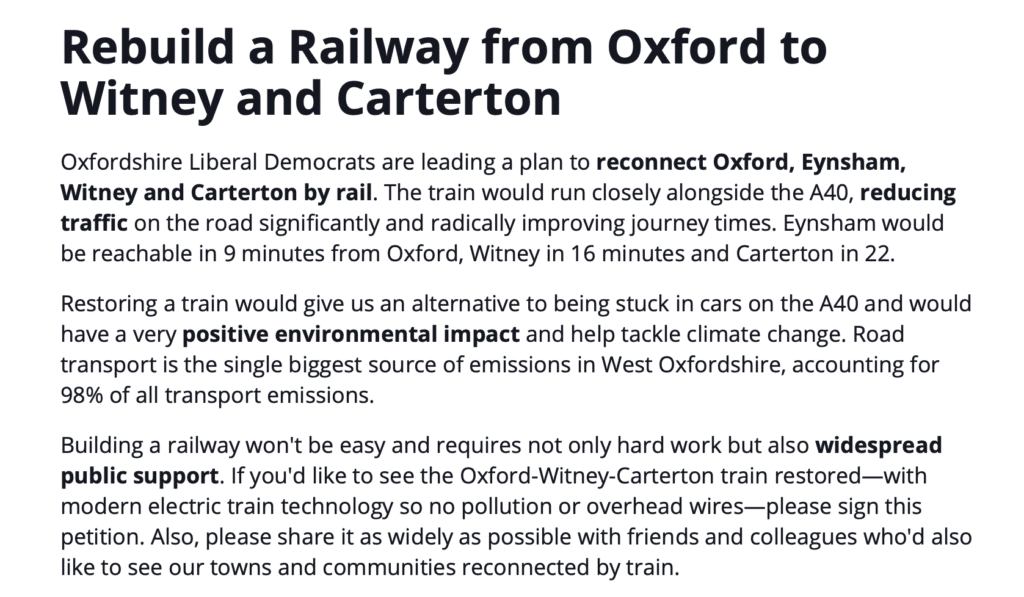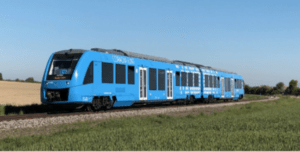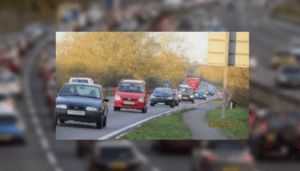TRAIN SPOTTING
A recent post in I Love Witney Group got me thinking about the differing opinions, some very strongly held, about the pros and cons of a new railway link to Oxford.
“There are people working very hard at the moment to try and make this happen and it is gaining some traction….train line from Carterton to Oxford, stopping at Witney and Eynsham. If you want this to happen please please sign this petition and spread to as many as you can”. Group Member

It would spoil the beautiful town
“If Witney had a train station to Oxford it would spoil the beautiful town, it would be estate after estate built for all the commuters, and house prices would go up. Not having a station is what has kept its charm. Just look at Swindon and Didcot, it’s my personal opinion but I think it’s a terrible idea”
Be careful what you wish for...
“If we get the rail-line back then the door will open for more development in Witney, Carterton and Eynsham as they will say we have the transport links and infrastructure.
Be careful what you wish for if you like living in a small town……..”
Less cars on the road
“Great idea just a shame there isn’t any money for it! You couldn’t reuse the old line due to the developments on top of it so the cost to rebuild from scratch would astronomical. It would be awesome tho, less cars on the road is always a positive!“
I don’t think either will ever happen
“I have said for years we need a train link from Witney and Carterton to Oxford, same as the A40 she have been made into dual carriageway at least forty years ago, sadly I don’t think either will ever happen”
Rising House Prices
“Enjoy the rising House prices and extra developments that will come with the train line“
It’s a sound aspiration
“It’s a sound aspiration. A better intermediary would be a ‘busway’, or light rail, far less to build per KM, cheaper project = lower fares . Nothing in here about how to connect the multi modal start / end of the journey. Which also needs resolving. How would one get to the station?
FOR
We approached Charlie Maynard (Chair, Witney Oxford Transport Group) for his views on a new train line

Taken as a whole, Carterton, Witney and Eynsham and the surrounding villages represent one of the largest populations in the country not connected to the rail network. The poor transport links in the district generate many negatives including reduced access to employment and education; deterring employers from locating locally; slow, stressful and unpredictable journeys; and increased pollution.
We believe that a rail line would help West Oxfordshire and the county as a whole to prosper by providing a fast corridor along which people can rapidly and sustainably move, providing West Oxfordshire residents far greater access to job and education opportunities.
Given the layout of Oxford with single lane roads leading into the centre and a very congested ring road, it’s clear that the fastest way both into Oxford and around Oxford is by rail. See here for a Google Earth presentation outlining a potential route, connecting into the Cotswold Line at Yarnton. A restored rail line would cut journey times enormously, with trains running from Eynsham to Oxford in 9 minutes, Witney to Oxford in 16 minutes and Carterton to Oxford in 22 minutes. This would substantially reduce congestion on the A40 and take a material number of cars off the road.
The rail line will also enable fast travel beyond Oxford, whether it is continuing on along the Cowley line (post conversion from freight to passenger traffic) to the business and science parks southeast of the city; or to other regional centres such as Didcot, Bicester, Bletchley; or to London, Birmingham or along the upcoming East-West Rail link to Cambridge.
Some people think that if we just stick with really bad infrastructure that we won’t get more housebuilding in the district, but that’s wrong. As per the District’s Local Plan(see p46), the District Council has committed to building 10,450 new homes in the district between 2021 and 2031. This is at the national and county government’s command, so we are getting the houses whether we like it or not. Being realistic, 2031 will not be the end of housebuilding in the district. Importantly, this is all happening irrespective of whether a train line is built or not. Therefore we have the choice, either to stick our heads in the sand and hope it will all go away, or we can decide to take control to the maximum extent possible and create infrastructure which is fast, sustainable and serves our needs as residents. The planned bus express lanes for four miles from a park & ride at Eynsham to Wolvercote roundabout will help, but they are unlikely to make more than a minimal difference to overall journey times given they make up a small fraction of the 17 miles by road from Oxford to Carterton and that the road congestion in Oxford and Witney will be unchanged.
We're Going To Get More Housebuilding
Some people think that if we just stick with really bad infrastructure that we won’t get more housebuilding in the district, but that’s wrong. As per the District’s Local Plan(see p46), the District Council has committed to building 10,450 new homes in the district between 2021 and 2031. This is at the national and county government’s command, so we are getting the houses whether we like it or not. Being realistic, 2031 will not be the end of housebuilding in the district. Importantly, this is all happening irrespective of whether a train line is built or not. Therefore we have the choice, either to stick our heads in the sand and hope it will all go away, or we can decide to take control to the maximum extent possible and create infrastructure which is fast, sustainable and serves our needs as residents. The planned bus express lanes for four miles from a park & ride at Eynsham to Wolvercote roundabout will help, but they are unlikely to make more than a minimal difference to overall journey times given they make up a small fraction of the 17 miles by road from Oxford to Carterton and that the road congestion in Oxford and Witney will be unchanged.
When making decisions we need to think not just about the next three, five or ten years, but what makes sense over the next twenty, fifty or one hundred years. We also need to go step by step. Witney Oxford Transport Group is submitting an application to the Department for Transport’s Restoring Your Railways Ideas Fund by March 5th for a £50,000 grant to fund a feasibility study.
To date we have received letters of support for this bid from Witney Town Council, Carterton Town Council, Eynsham Parish Council, the Lord Mayor of Oxford, Oxford University and Grosvenor, the developer of the Eynsham Garden Village. We’re thrilled and very grateful to have their support. However, most of all, we want to hear from everyone who lives in the distric
AGAINST
We asked local Stuart McCarroll for his opinion on this issue

The days of big industry providing housing stock to keep the workforce within a few miles are gone; besides no one could afford cars and bike use was commonplace. Mobility continues to be the beating heart of our towns, cities, lives and economy, however our arteries are clogged in and between towns.
There were 20 million vehicles in 1980’s and that’s almost doubled now. Congestion is killing through excess pollution deaths and destroying time and space to live. The biggest issues in urban mobility revolve around the ability to get door to door. Travel patterns in all directions is the complication. How we achieve this first and last mile to any mass transit hub is critical to the success or failure of any proposed solution – without the spider’s web of connectivity from bus and cycle routes, rail could be an expensive and still ineffective at resolving the A40 without a slick multi-modal travel network.
Do you want a railway is a really easy question to ask, and at first glance the answer is, of course! Its far better than road, when the A40 will never be ‘wide enough’ to meet the demand of increasing populace Oxford City, Carterton, Eynsham and Witney.
Covid has proven many can work productively from home. Businesses are looking again at workspaces. So Rail appears a much bigger cost/risk than just 1 year ago. Working patterns change and we cannot be fixated with rail as the silver bullet as it is far too easy to promise and yet the hardest of all options to deliver especially compared with the splashing a little more tarmac on the A40 (which won’t work).
Single Occupancy Vehicles
The Failure of road
Look around you next time you’re on your commute, how many drivers are in a vehicle by themselves. Single occupancy vehicle entitlement is testament to the failure of road, and car dependency has allowed us to live anywhere and be more dependent on road without extensive bus or rail
Planning, a failure of government encouraged this with drive throughs and out of town development pushing car use. Community Infrastructure Levy and S106 as currently used cannot fund required bus improvements, so it’s a race to the cheapest corners being cut.
Fixing the issue means fixing our own behaviours as all solutions require a culture shift. Busways, allow large lengths of routes, so more door to door, but clearly slower than rail but cheaper to construct and maintain than full rail.
It does depends on roads in each town also being traffic free. Light rail has lower capacity and upfront costs to build than typical rail, but often lacks capacity to take bikes on board.
Employers already know which employees live near each other, but car share schemes are voluntary. Is it time to ditch passive car share schemes for a multi-car occupancy lane on the A40?
Can a 200 year old rail idea to bring Rail back a West Oxfordshire line toward Oxford City & beyond be part of the answer?
Being the harder solution doesn’t mean doubters should give it up. However it can only deliver for us if we all change behaviour, reducing our short trips within towns (66% of all car trips are under 5 miles, 38% under 2 miles, 20% under 1 mile) to create congestion free road space for buses and cycles to easily get to & from stations.
Witney Oxford Transport Group are rightly calling for a feasibility study for rail. We can’t know for sure unless we examine it properly, which must include the environmental cost in inaction and staying on the road.
Achieving seamless mobility will not be easy, but it can’t be built on romanticism of rail unless we also can learn to share road space for active travel and for those than can’t, to share space inside our vehicles as well to and from terminals. Multi-modal travel unpins the success of any mass transit work through our towns in rural west Oxfordshire. It’s this political thistle few are willing to properly grasp.





